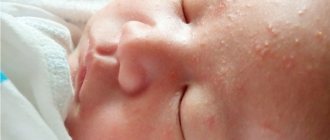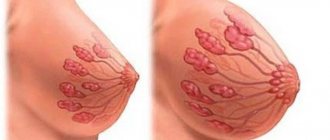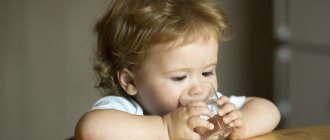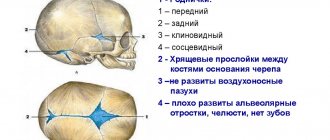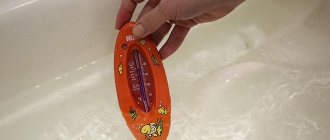Everything that happens to the health of the baby causes concern among young parents. They do not know how dangerous certain changes in the child’s behavior and appearance are. Particular concern arises if a baby has swelling in one or two eyelids at once - what to do in this case? Find out why babies' eyes may swell.
In this article
- Eyelids swell in infants: symptoms
- Why the lower or upper eyelid may swell in a baby - possible causes
- Eyelids are swollen - what examinations are needed?
- Allergic eye swelling in infants: symptoms and treatment
- The baby's eyes are watery and the eyelids are swollen - what to do?
- The lower eyelids of a newborn baby are swollen due to dacryocystitis - what to do?
- The eyes are swollen, a child has stye - what to do?
- Prevention of eyelid swelling in children
Eyelids swell in infants: symptoms
Have you noticed that the child’s eye is swollen and the upper eyelid is red, and the baby himself is restless: does he cry a lot and does not sleep? In such a situation, consultation with a specialist is necessary. You should not try to relieve swelling on your own and wait for improvement within a few days. After all, a symptom such as swelling of the eyelids is a clear signal from the body about the presence of allergies, the development of an infection or serious systemic pathologies, or kidney problems. An experienced diagnostician, after a visual examination of a child whose eyelid is swollen, will prescribe an additional consultation with an ophthalmologist, allergist, etc. Only if the diagnosis is correct can the disease be dealt with quickly and its recurrence prevented.
Baby's eyelids swell - symptoms:
- the baby's eyelids are swollen - if the baby's two eyelids are swollen at once, and the eyes are red and itchy, it is possible that the baby is developing an allergy;
- swollen lower eyelids - the lower eyelids in children often swell due to prolonged crying, poor sleep, such swelling can be physiological and is present in many infants, but it is also observed with an allergic reaction, kidney disease, etc.;
- the newborn’s eyes are red, swollen and watery - if the swelling of the eyelids is bilateral and is accompanied by lacrimation and redness, this indicates the development of viral or bacterial conjunctivitis;
- only one eyelid swells, the lower one - severe swelling under one eye may indicate a problem such as dacryocystitis, obstruction of the tear duct;
- a child's eyelid is swollen and painful - this can be a symptom of stye, which causes itching and pain during the ripening period.
In many cases, swollen upper and lower eyelids in infants are the result of prolonged crying and an uncomfortable position during sleep. Such conditions are not dangerous and pass quickly. If you have been observing swelling in your child for several days, be sure to visit a doctor, since frequent swelling is not the norm.
Causes of swelling
The occurrence of puffiness and bags in the eye area, especially after sleep, can be due to many reasons.
The most common problems, the symptom of which are bags under the eyes:
- hormonal disorders;
- inflammation in the genitourinary system;
- impaired functioning of the kidneys, liver or heart;
- increased intracranial pressure;
- allergy;
- conjunctivitis.
In addition, children from 7 months to 2 years usually experience swelling under the eyes due to teething. In children of preschool and school age, bags under the eyes are the reason for spending a long time at the computer or TV.
Another reason for puffiness around a baby’s eyes is poor nutrition. In particular, food rich in salt. Salt settling inside the body retains water, resulting in bags under the eyes.
It happens that newborns' eyes swell and become red after crying heavily.
Whatever the cause of swelling, it is necessary to take measures to eliminate it. Treatment can be prescribed by a doctor after examination and certain studies.
Why the lower or upper eyelid may swell in a baby - possible causes
A doctor must determine the exact cause of any ailment or unstable condition in an infant. If your baby's eyelids are swollen, you should first visit a pediatrician. If necessary, he will either prescribe an additional examination by a specialist - an ophthalmologist, an allergist, a cardiologist, or propose a correct treatment plan.
Why do the upper or lower eyelids of a baby swell - possible reasons:
- physiological swelling of the lower and upper eyelids - observed in newborns in the first weeks of life, if the swelling persists longer, consultation with a pediatrician and additional diagnostics are necessary;
- trauma, foreign body - the upper or lower eyelid may swell, since the child’s eyes are very sensitive, and even a small speck or eyelash that gets into the eye can cause swelling of the eyelids, in this case the process will be one-sided;
- conjunctivitis - newborn children are prone to conjunctivitis, since in the first months of life their eyes do not produce enough tears, and are therefore vulnerable to bacterial and viral infections;
- allergies - at risk are children with weak immunity, those on artificial nutrition, as well as those whose parents are allergic (with allergies, two eyes usually swell);
- dacryocystitis - if a baby’s lower eyelid is swollen and does not go away, it may be a blockage of the lacrimal canals, which leads to the appearance of edema; the disease can be congenital or acquired (often a one-sided process);
- barley - with barley, usually one eyelid swells - the upper or lower one, turns red and localized inflammation is visible on it; after the barley ripens, with adequate treatment, the swelling of the eyelids goes away.
If a child has a cold that lasts a long time and the eyelid is swollen, this may mean that the disease is complicated by inflammation of the paranasal sinuses. If your baby has been sick for several days and his upper or lower eyelids begin to swell, contact your pediatrician. It is possible that the child develops sinusitis, which, in the absence of adequate treatment, can become chronic and complicated by inflammation of the jaw, lower and upper eyelids, and orbit.
Carrying out the operation
Probing and rinsing the lacrimal canal in children lasts approximately 5-10 minutes. In this case, stationary placement is not required. At the end of the procedure, the little patient is sent home, where subsequent outpatient treatment takes place.
Before the procedure, a local anesthetic is instilled into the eye. The skin around the eyes is disinfected.
Probing of the tear ducts is more than 90% effective! In rare cases, it is necessary to resort to a repeat procedure. Many parents are afraid of surgical intervention, but in fact the probing procedure is not so scary, it is quick and completely painless.
Eyelids are swollen - what examinations are needed?
Despite the similarity of the symptoms of diseases in which the lower or upper eyelids swell, there are still significant differences that can be used to preliminarily assume the presence of one or another disease. During a visual examination of the child, doctors take into account how often the eyelids swell, whether the process affects both eyes or only one, whether the baby is breastfed or on artificial nutrition, and also examines the medical history, including that of the parents.
Swelling of the lower or upper eyelids - diagnosis:
- visual inspection;
- allergy tests;
- scraping from the eyelids for microbiological examination;
- blood and urine tests;
- consultation with an ophthalmologist, allergist.
What to do if a baby's upper eyelid is swollen? What is the reason for this condition? Among the unobvious reasons why a newborn's eyelids may swell are diseases of the stomach and intestines, diabetes mellitus, and weakened immunity. Therefore, parents should react as quickly as possible to any changes in the child’s health and seek help from specialized specialists. Remember that you cannot ignore a painful condition for a long time if a child’s eyes are swollen, trying to cure, for example, compresses, allergic swelling. Without specific treatment for allergies, there is a high threat to the child’s life.
Allergic eye swelling in infants: symptoms and treatment
Allergies in newborns can manifest themselves in the form of swelling of the eyelids, rashes, and redness on the skin. Since the child is still too young, parents do not have information about intolerance to certain substances, nutritional components, or medications that can cause unwanted symptoms. Those at risk of having swollen eyes due to allergies include not only formula-fed children, but also those who are breastfed. Allergies to breast milk are not uncommon. Also among allergic agents: pollen, dust, washing powder, pet hair, creams, shampoos, soaps and other hygiene products.
If a child has allergies, the upper and lower eyelids may swell. Allergic swelling of the eyelids may appear periodically. This is due to the type of allergen and how often the child comes into contact with it. If this phenomenon is left unattended, the allergy may intensify, which will lead to a worsening of the condition. With allergies, not only the eyelids often swell, but also the throat, tongue, and lips, which makes breathing difficult and threatens the child’s life.
Symptoms of allergic swelling of the eyelids in children:
- redness of one or both eyes;
- severe itching - the child will show anxiety, older children rub their eyes;
- swelling of the eyelid, narrowing of the palpebral fissure.
If a child's upper (or lower) eyelid is swollen, this should alert parents. In the first hours after symptoms appear, the baby needs help. Allergies are treated by an allergist who, taking into account the severity of the disease, draws up a treatment regimen. It includes antihistamines, as well as preventive measures to strengthen the immune system.
Komarovsky about bags under the eyes of infants
In his program, Dr. Komarovsky talks about bags under the eyes of babies. He says that this phenomenon occurs in all children immediately after birth. The swelling should gradually decrease, and 2 weeks after birth it will completely disappear.
If swelling persists after this time, you should consult a pediatrician and specialist doctors. Perhaps the symptom is caused by a disease of the internal organs. If it is detected early and treatment is started, in most cases the prognosis will be favorable.
If there is prolonged swelling, you should adhere to the drinking regime for infants. If the baby is only breastfed, the amount of milk consumed is not limited. This is because it is not considered a liquid as it curdles inside the baby's stomach.
The baby's eyes are watery and the eyelids are swollen - what to do?
Young children often have swollen and watery eyes when conjunctivitis develops, and purulent discharge may also be present. This happens if a bacterial infection occurs due to infection or improper care of the newborn. What should you do if your baby’s eyelids are swollen and conjunctivitis begins? It is necessary to follow all stages of treatment prescribed by the doctor.
Treatment of conjunctivitis in newborns:
- cleansing the eyes of pus - if the eyes are swollen and there is pus, you need to use a warm antiseptic solution based on boiled water;
- antibacterial therapy - for microbial infections, eye drops with an antibiotic are prescribed; for infants, drugs with the least degree of toxicity are selected;
- antiviral and antimicrobial ointments - depending on the type of infectious agent, the drug is prescribed in the form of an ointment, which must be carefully placed behind the newborn’s eyelid.
To wash the eyes, you can also use decoctions of herbs that have an antiseptic effect, but first you need to make sure that the child is not allergic to one of the components of the herbal collection. Decoctions of herbs such as chamomile, calendula, and sage are best suited for cleansing the eyelids of pus.
The lower eyelids of a newborn baby are swollen due to dacryocystitis - what to do?
Is your baby's lower eyelid swollen? This could be dacryocystitis. Blockage of the tear duct in infants can be congenital or acquired. In the fetus in the womb, the tear ducts are closed and protect the respiratory system from the ingress of amniotic fluid. Normally, at the birth of a child, the tear duct should open - the baby cries, and under pressure the film breaks and the ducts open. If this does not happen, the newborn may develop dacryocystitis due to tear stagnation - the lower eyelid will swell. Secondary dacryocystitis, in which the lower eyelid swells, develops in older children against the background of prolonged illness or injury.
If you notice that your child’s lower eyelid or eyelid above the eye is very red and swollen, contact your pediatrician - the doctor will prescribe a course of specialized treatment. Without treatment, swelling does not go away; the disease is complicated by purulent infectious conjunctivitis, which can affect the baby’s visual acuity. Often with dacryocystitis, a fistula of the lacrimal sac appears. Dacryocystitis is diagnosed by an ophthalmologist by performing a tear duct patency test.
How to treat dacryocystitis, in which the eyelid swells:
- regular hygiene of the eyelids, cleansing the eyes of pus and discharge - if the eyelid swells severely and there is discharge, antiseptic solutions are used;
- antibacterial drops and ointments - drugs are prescribed by a doctor based on the results of cultures and the sown microflora;
- massage - using movements with light pressure, it is necessary to massage the area from the corner of the eye and along the nasal septum, repeating the exercise up to 10 times, two to three times a day.
Parents of children whose lower or upper eyelids swell should be extremely careful and responsible, since the symptoms of this disease are often confused with conjunctivitis and they try to treat it with compresses, eye drops, etc. In the case of dacryocystitis, even after antibacterial therapy, the improvement will be insignificant, since, in addition to medications, massages are also necessary to free the lacrimal canal. If conservative methods are ineffective and the eyes are still swollen, surgery is prescribed - puncture of the lacrimal canal.
Causes
Blocked tear ducts occur for the following reasons:
- congenital pathologies associated with anatomical narrowing of the lacrimal canals;
- non-resorption of the protective gelatinous plug after childbirth, which normally covers the nasolacrimal duct to prevent the ingress of amniotic fluid;
- blockage of the nasolacrimal duct by the embryonic membrane.
The eyes are swollen, a child has stye - what to do?
The appearance of a small reddened bump on a child’s eyelid may indicate the development of a stye. Usually, the eyes swell and a boil appears in a child when his immunity is weakened, and also if the baby is overheated or frozen. Staphylococcal infection can also provoke the development of barley. If you notice that your child's upper or lower eyelid begins to swell and a stye appears, consult a doctor so that he can prescribe a suitable ointment that will soften the skin and speed up the ripening of the stye.
How to treat stye in a newborn:
- cleansing the surface of the eyelids from secretions - if the eyes are swollen and there is mucus and secretions, use a warm solution of furatsilin; cool liquids can be harmful, since cold provokes stagnation;
- warm compresses based on herbs with an anti-inflammatory effect (provided the child has no allergies) - for barley, decoctions of chamomile and dill seeds help well;
- antibacterial ointments are placed behind the lower eyelid - this way they are evenly distributed on both the upper and lower eyelids; the ointment is necessary to prevent bacterial infection;
- eye drops are prescribed if the eyes are swollen and conjunctivitis develops with stye.
What to do if the upper or lower eyelid swells and hurts? In the case of a child, visiting a doctor is mandatory, and adults should not ignore such dangerous conditions. It is better to seek advice in a timely manner. The choice of drugs for the treatment of barley in infants is small, so their selection should be carried out by a specialized specialist who will take into account the child’s age, his tendency to allergies and select the optimally suitable medications.
Diagnostics
The very first test to determine the cause of swelling can be carried out by parents at home. It is not difficult to determine the presence of swelling on the face and in the eye area; it immediately catches the eye. When swelling is localized on the extremities, you just need to lightly press on the baby’s arm or leg. If the pressure mark remains for a long time, then perhaps the problem has deeper roots.
If, after a preliminary examination, the doctor suspects inflammation of the genitourinary system, then the child is sent for a urine test and an ultrasound examination of the kidneys and urinary tract.
When a doctor suspects that a child has an allergy, he will most likely order a general and biochemical blood test and allergy tests. These can be provocative tests or the so-called Prick test.
Prevention of eyelid swelling in children
Hand hygiene by a mother who constantly interacts with her baby significantly reduces the likelihood of developing a bacterial infection, which is what causes the baby’s eyes to swell. The better the care of the baby is organized, the optimal microclimate in the house is constantly maintained, the less the risk that the eyes will swell due to conjunctivitis.
How to avoid recurrence of eyelid swelling in infants:
- gently washing the child with warm boiled water, caring for the surface of the newborn’s eyelids;
- scheduled dry and wet cleaning of the room where the child is located;
- regular ventilation of the room, timely hygiene procedures;
- balanced diet, healthy sleep, massages;
- air humidification during the period of central heating operation - due to dry air, the mucous membranes of the eyes are irritated, they become vulnerable to various infections, and may swell;
- Walking in the fresh air strengthens the child’s immunity, which helps prevent allergies.
A baby's eyelids may swell and hurt due to improper diet, unbalanced nutrition of the mother, etc. Remember that swelling of the upper or lower eyelid is not the norm; they are often a symptom of dangerous pathologies: anemia, thyroid diseases, problems with internal organs. Therefore, try to get advice from a qualified specialist as quickly as possible.


